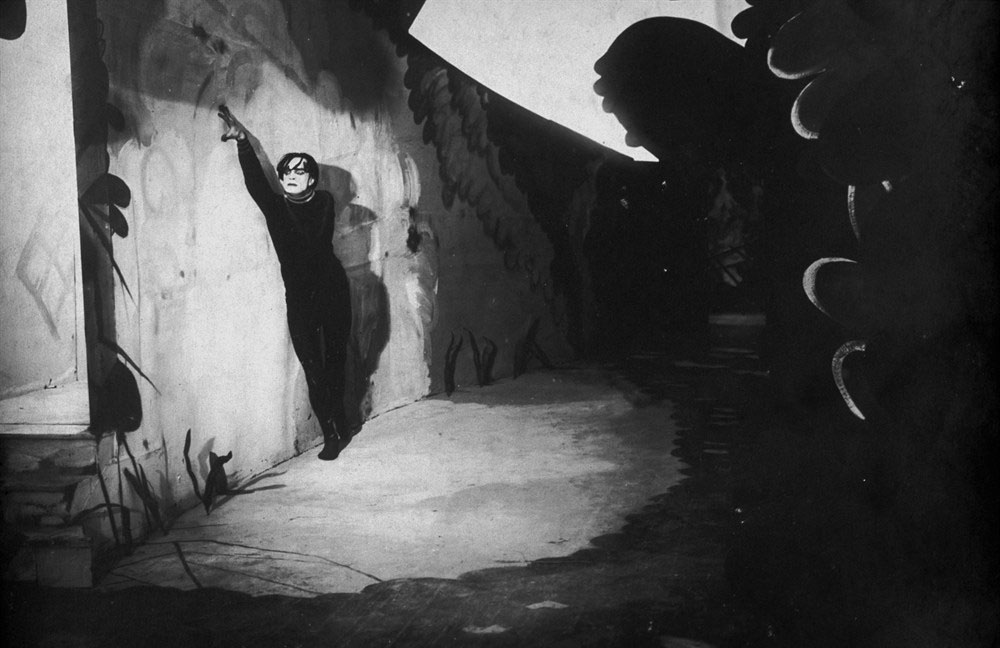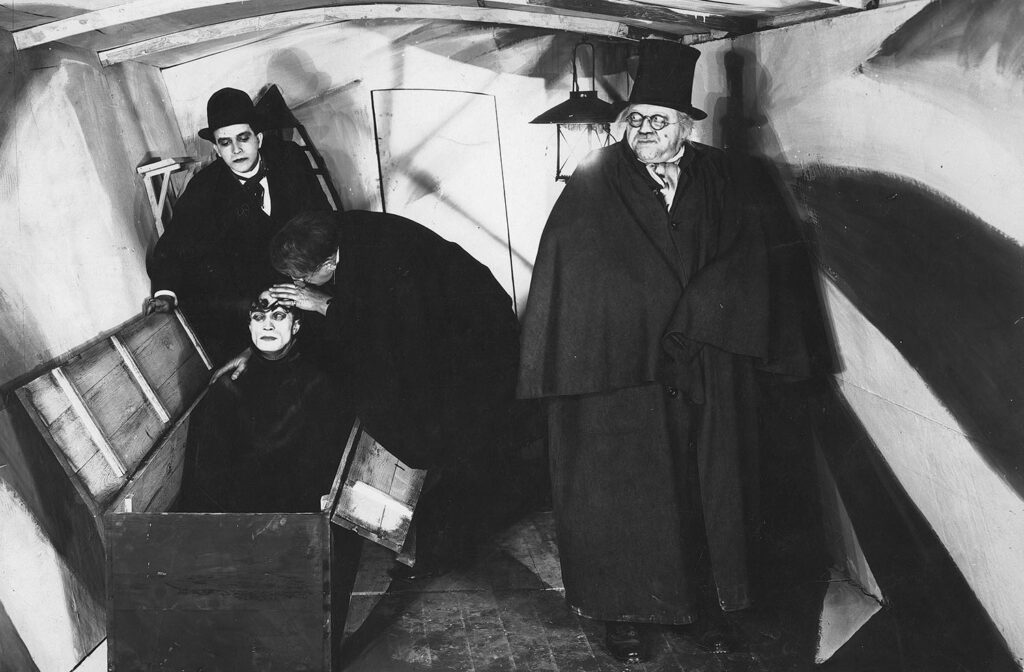Watching “The Cabinet of Dr. Caligari” is like being imprisoned in Edvard Munch’s painting “The Scream,” forever suspended in the silence of unending anguish. This silent German Expressionist masterpiece is a brilliantly realized nightmare whose antique acting style and visually arresting sets and costumes are as exciting and moving as a great 19th Century opera or ballet.
“The Cabinet of Dr. Caligari” is a seminal work of what in German is called helldunkel. It is German Romanticism warped by the soulless devastation and incalculable loss caused by the First World War. Where WWI suffocated the light of the German soul, psychoanalysis and nihilism filled the void. Beauty is abandoned as an artistic end and the monsters of the subconscious creep and slither freely across the face of German art.
In cinematic Expressionism, the actors do not project their inner lives, emotions, and thoughts outward for the viewer to catch and interpret from their performances. The actors inhabit a concrete, external construction of their dreams, desires, and demons. The subconscious realms so recently described by Freud, Jung, and other psychoanalysts were depicted during the inter-war period for us to see in the skewed perspective of the sets, the abandonment of the rules of perspective, the dramatic chiaroscuro lighting, and the outlandish costumes. And we watch the characters negotiate the shifting sands of this dream-reality.
The actors themselves move in a strictly stylized way based on the ubiquitous Delsartre System of Bodily Expression. This system of gesture, created by a French singing coach, penetrated into training for actors, orators, singers, and the new “modern” dancers such as Isadora Duncan. It was a new kind of movement system intended to free the performer from stiffly mannered expression and, instead, teach them how to appear more gracefully “natural.” It is not what we would call natural today because acting has changed greatly. But when the system is used by talented actors like the cast here, it is exciting, expressive, and dynamic.

But “The Cabinet of Dr. Caligari” is more than a period piece; it is a thriller. The protagonist Francis (Friedrich Feher) races through streets tilted at impossible angles desperately trying to discover the identity of a serial killer and unravel the mysteries of Dr. Caligari. He spirals like a character in a Kafka novel through nightmarish absurdity.
In order to tell the story of the serial killer, Cesar the Somnambulist, who lives in a waking dream, Conrad Veidt employs his Delsarte training to allow us to see into the mind of the sleepwalker. The shell that Cesar has become walks, speaks, and kills only at the behest of Dr. Caligari. He has no inner life and no will. That is the wonder of Veidt’s performance; he is able to embody a compelling blankness, looming violence, and poignant beauty all in one being. Cesar is perhaps the emblem of the post-war shellshocked remnants of Germany’s young manhood. He may even be the archetype of what Germany’s soul became after its defeat and humiliation in 1918. Veidt’s performance is supported by every other aspect of the film. There is nothing lovely, safe, or rational about the landscape. The sets are pointed, skewed, and sharply shadowed, denuding the world of comfort.
All of the techniques deployed here so brilliantly will form the basis of film noir when the great German filmmakers and actors begin to emigrate to Hollywood as the Nazis rise. These filmmakers and their new American colleagues will take the brutalist components of Expressionism, mold, round, and recycle them to convey American disillusionment following the Second World War in a more refined, palatable way. The beautiful chiaroscuro of “Out of the Past” (1947) and the vertiginous camerawork of “The Big Clock” (1948) are owed to these early German Expressionists.
For more viewing, “Metropolis” (1927) is the most famous of the German Expressionist films. To see a Hollywood adaptation of the style, I suggest watching (or re-watching) “Casablanca” (1942). The special link here is that Conrad Veidt who played the Somnambulist in “The Cabinet of Dr. Caligari” plays the Nazi Major Strasser in Casablanca.



1 Comment
Hello and thank you for this lovely post. I am writing a new biography of Conrad Veidt. You write, “Conrad Veidt employs his Delsarte training.” I am hoping you can help me find original source material that substantiates substantiates that this was his acting training.